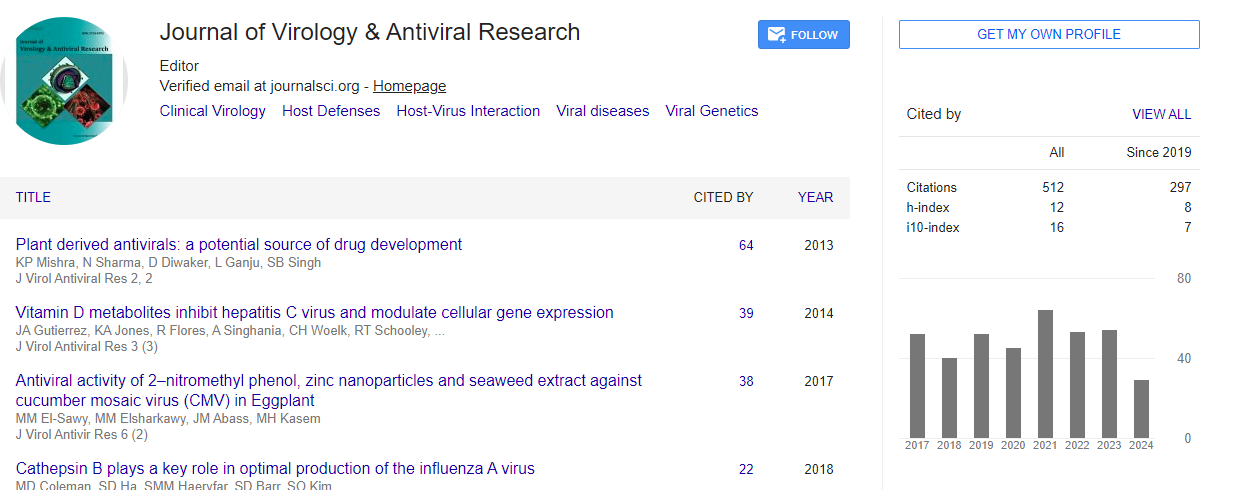Research Article, J Virol Antivir Res Vol: 10 Issue: 2
Hepatitis E Viral Infection in Pregnant Ladies, a Challenge for Obstetricians and Physicians
Samia Jamil1, Mahliqa Maqsud1, Mehwish Ayyaz1,Tayyaba Kanwal1, Hafiz Muhammad Sajid Jehangir2, Hamza Naeem2, Samar Firdous2 and Sarmad Zahoor2*
1Department of Medicine, King Edward Medical University, Lady Atichoson Hospital, Lahore, Pakistan
2Department of Medicine, King Edward Medical University, Mayo Hospital Lahore, Pakistan
- Corresponding Author:
- Dr. Sarmad Zahoor
Department of Medical
King Edward Medical University
Lady Atichoson Hospital, Lahore, Pakistan
Tel: 0923336431557;
E-mail: drsarmadzahoor@gmail.com
Received: December 06, 2020 Accepted: March 22, 2021 Published: March 29, 2021
Citation: Jamil S, Maqsud M, Ayyaz M, Kanwal T, Jehangir HMS, et al. (2021) Hepatitis E Viral Infection in Pregnant Ladies, a Challenge for Obstetricians and Physicians. J Virol Antivir Res 10:2.
Abstract
Background: Hepatitis E Virus (HEV) is the major cause of morbidity and mortality in pregnancy. The virus was detected about three decades ago. The incidence and severity during pregnancy vary widely around the world.
Material and methods: This observational retrospective study was conducted from March 2019 to February 2020 in Obstetrics & Gynaecology Department of Lady Aitchison Hospital, Lahore. 70 pregnant women with hepatitis E were subjected to detailed history taking. The diagnosis was based on positive Hepatitis E IgM (Anti HEV IgM) antibody on laboratory test in current pregnancy in antenatal period up to 42 days post-partum were included.
Results: Out of 70 pregnant women with Hep E IgM+ve, 3 (4.3%) women had Obstetrical hysterectomy as complications, with mean age of 26.0 ± 4.69 years. The mean gestational age when infection occurred was 31.12 ± 5.18 weeks. Among all females 9 (13%) patients expired due to fulminant hepatic failure, 12 (17.14%) females gave birth via spontaneous vaginal delivery (SVD),17(24.2%) females gave birth via C-Section. 30 (42.8%) females were manage conservatively.
Conclusion: Hepatitis E viral infection in pregnant females is a life threatening condition. The study showed that pregnant women with jaundice and hepatitis E virus infection had a high mortality rate during third trimester. Early diagnosis and management will help in the control of the disease and prevents its complications.
Keywords: Hepatitis E Virus; Pregnancy; RNA virus; Immunoglobulin
Keywords
Hepatitis E Virus; Pregnancy; RNA virus; Immunoglobulin
Introduction
Hepatatis E virus infection in human exists in early stages of life in highly epidermic areas of genotype 1 while genotype 3 is endemic in adults, where this virus is responsible for around 10% suspected cases of acute idiopathic infection and for several subclinical, underdetermined infections [1, 2]. The virus was detected about three decades ago. It causes a serious threat to health, life and efficiency in all developing countries where clean water is inaccessible or limited [3]. This infection has become an emergent cause of acute infections all over the world. It is also the major cause of water-borne epidemic disease in poor sanitary areas in tropical and sub- tropical regions [4]. The incidence and severity during pregnancy vary widely around the world. In Western Europe and North America, the incidence is as low as one in 20,000, whereas in outbreaks of waterborne Hepatitis E in India and Asia, the case fatality rate is 1–2 % and up to 10–20 % in pregnant women [5].
Hepatitis E is the major reason for development of hepatitis and mortality in developing countries. It is responsible for large number of mortalities in pregnant females [6, 7]. Hepatitis E virus has single stranded RNA, which is non-enveloped. It is the only virus within the genus Hepatitis E virus [7]. A cross sectional study was conducted in 2013. In third trimester, maximum maternal morbidities were noted in patients, both clinically and derangement of haematological and biochemical tests. Out of 30 patients, 08 patients expired with maternal mortality rate of 29.3%. Perinatal mortality rate was 30.3 per 1000 live births. Hepatitis E runs a fulminant course during pregnancy with very high mortality rate especially during third trimester and postpartum period [8].
The study population was pregnant women with acute hepatitis E infection confirmed by ELIZA technique. Out of the total 45 admitted pregnant women with hepatitis E viral infection, 22 women (48.9%) had severe complications. The most common were hepatic coma in 8 (36.36%) cases and disseminated intravascular coagulation in 14 (63.63%) cases. Highest mortality rate was seen in women with hepatic coma (100%), while in those with disseminated intravascular coagulation, one out of the 14 cases (7.14%) died.7This study was conducted to determine the frequency of Hepatitis E virus in pregnancy, its clinical presentation, maternal mortality and perinatal outcome.
Material and Methods
This Observational retrospective study was conducted from March 2019 to February 2020in the Obstetrics & Gynecology Department of Lady Aitcheson Hospital, Lahore. It was initiated after obtaining permission from the Institutional Review Board of the hospital. Informed written consent was obtained from the patients. A total 70 patients admitted in isolation ward of gynaecology Department by using non probability sampling technique were included. Sample size 70was calculated with 95% confidence level and 5% level of significance by taking 5% frequency of pregnant females who suffer from hepatitis E virus by using formula.
n=Z2 (p) (1-p)/d2n
All pregnant women with hepatitis Ewere subjected to detailed history taking regarding present history like gestational age, gravidity and pavity. The patients were diagnosed bases on positive serology for Hep E Igm in current pregnancy during antenatal period or 42 days postpartum. Diagnosis was also made on signs & symptoms of jaundice, vomiting, deranged LFT investigation, vomiting, fever and loose motion. All these patients were followed during their hospital stay of 3-5 days regarding pregnancy status, either induced or spontaneous onset of labour, mode of delivery, either SVD or C-Section , TOP or conservative management, any complications including obstetrical, medical and surgical and mortality rate were noted. SPSS version 21.0 was used to enter and analysed the data.
Quantitative data like age, gestational age were presented as means and standard deviation and qualitative data like parity, mode of delivery or presenting complaint etc… was presented as frequency and percentages.
Results
Out of 70 pregnant women with Hep E IgM+ve, 3(4.3%) women had Obstetrical hysterectomy as, with mean age of 26.0 ± 4.69 years. The mean gestational age when infection occurred was
31.12 ± 5.18 weeks.
Out of 70 cases found majority were diagnosed to be hepatitis E positive in their third trimester, while very few were infected in the first and the second trimester. The mean parity was 2.12 ± 0.86. Among the pregnant women, 22(31.4%) females were Primigravida, total 17(24.3%) cases were in second trimester and 31(44.3%) were in third trimester who developed infection.
Table 1 24 (34.3%) patients presented with gerenalized + sclera yellowish discoloration.
Table 1: Demographics of females (n=70)
| Age | 26.0 ± 4.69 |
| Gestational Age | 31.12 ± 5.18 |
| Primigravida | 22(31.4%) |
| Second Trimester | 17(24.3%) |
| Third Trimester | 31(44.3%) |
Table: 2 Clinical symptoms of females at presentation
7 (10%) presented with Labor pain and fever; 18 (25.8%) patients presented with deranged LFTs on routine investigation, 6 (8.6%) patients presented with generalized itching all over the body, 4 (6.9%) with loose motion and upper abdominal pain, 3 (4.2%)with fever and Hepatitis E virus respectively and 8(11.5%) presenting with Loose motions (Table 2).
| Clinical Presentation | Frequency (%) |
|---|---|
| Yellowish discoloration of sclera | 24 (34.3%) |
| Deranged LFTs on routine investigation | 18 (25.8%) |
| Itching all over the body | 6 (8.6%) |
| Loose motion & upper abdominal pain | 4 (6.9%) |
| Hepatitis E virus + Fever | 3 (4.2) |
| Jaundice & Loose motion | 8(11.5%) |
| Labor Pain & Fever | 7 (10%) |
Among all females 9(12.9%) patients expired due to fulminant hepatic failure. 33 (47.1%) females gave birth via spontaneous vaginal delivery (SVD),17 (24.3%) females who gave birth via C-Section (Table 3).
Table: 3 Obstetrical outcomes
| Mode of Delivery | Frequency (%) | |
|---|---|---|
| Discharged | 67 (95.7%) | |
| LAMA | 4 (5.7%) | |
| Shifted to medical department | 21 (30%) | |
| Expired due to Fulminant Hepatic Failure | 8 (11.4%) | |
| Delivered | SVD | 33 (47.1%) |
| C-Section | 17 (24.3%) | |
| Termination of Pregnancy | 11 (15.7%) |
Discussion
Hepatitis E virus infection has complex and not yet completely clarified, clinical- epidemiological characteristics. Hepatitis E-infected pregnant women have a higher rate of fulminant hepatic failure and higher mortality rate, compared with hepatitis E-infected non- pregnant women. Rein et al., recently published their estimates of the global incidence of hepatitis E infections and associated deaths in the year 2005, which suggested that >20 million infections and 3.3 million cases of hepatitis E per year, and a 20% probability of death in pregnant women infected with hepatitis E virus [9].
Patra found that most of the patients delivered vaginally i.e. 62% and 10% (i.e.5 patient) had to undergo lower segment caesarean section, rest were either abortion or did not deliver. In contrast our study only 12/33(17.14%) females gave birth via spontaneous vaginal delivery (SVD), 17(24.2%) gave birth via C-Section and the rest of the patients were manage conservatively and treated before the birth of baby [10].
In this study, all of the women were having hepatitis E IgM positive serology compared to other studies [7, 11, 12].The mean age of our study was 26.0 ± 4.69 years and majority of these women were in third trimester of pregnancy as compare to other studies the mean age was 27.78±6.7 years and also those women were in their third trimester of pregnancy [8, 13]. Hepatitis E infection during pregnancy is fulminant and fatal especially if it occurs in third trimester. The mortality in the second trimester is around 20% and reaches up to 45% in the third trimester, [14] as compared to our study in which the 9(13%) mortality rate was in third trimester of the pregnancy.
A paper published by Badrakiya et al., shows that maternal mortality rate among the pregnant women with hepatitis E infection was 20.5%,[15] in contrast in our study, only 9(13%) mortality rate was noted in third trimester of the pregnancy.
Various other studies found that majority of patients presented in third trimester and also the incidence of fulminant hepatic failure and maternal mortality was more in third trimester as compared to second and first trimester [16, 17]. In another study, the mortality rate was 29.3% and perinatal mortality rate was 30.3% and all mortalities noted were between third trimester & postpartum period. In comparison our study had only 13%(9) mortality rate in third trimester of the pregnancy [8].
Yellowish discoloration of urine or sclera was observed in 91.42% of patients in the study published by Mishra et al conducted in the year 2016, [18] In contrast our study 34.3% patients presented with gerenalized + sclera yellowish discoloration and diarrhoea.
In present study, 34% patients presented with Labour pain and fever followed by 25.8% with deranged LFTs on routine investigation, 8.6% with itching all over the body, 6.9% with loose motions or upper abdominal pain as compared to another study done in 2017, 92.5% of the patients presented with jaundice, followed by fever which was seen in 41.6% of the affected cases, while 20.83% of patients had nausea/vomiting and 12.5% presented with altered sensorium [19].
Shinde et al., almost all of cases in their study had nausea/ vomiting, 86.5% had jaundice, 58% had fever, while 21.1% had hepatic encephalopathy [20].
Conclusion
Hence according to various studies that have been analyzed most of the affected patients have clinical jaundice and other common complaints are nausea or vomiting, fever while more critical patients have hepatic encephalopathy.
Declarations
Ethics approval and consent to participate: All animal experiments had an ethical approval of the ethical committee of KU Leuven, Belgium and private facility for preclinical CRO Medanex Diest, Belgium.
Consent: Not applicable
Competing interests: The authors declare that they have no competing interests.
Conflict of interest statement: The authors have no conflicts of interest relevant to this article.
All authors have had an equal share in the intellectual contributions to this commentary.
References
- Capai L, Falchi A, Charrel R (2019) Meta-analysis of human IgG anti-HEV Seroprevalence in industrialized countries and a review of literature. Viruses, 11(1): 84
- Hughes JM, Wilson ME, Teshale EH, Hu DJ, Holmberg SD, et.al. (2010) The Two Faces of Hepatitis E Virus. Clinical Infectious Diseases, 51(3): 328-334.
- Krain LJ, Nelson KE, Labrique AB (2014) Host Immune Status and Response to Hepatitis E Virus Infection. Clin Microbiol Rev, 27(1): 139-165.
- Dagnew M, Belachew A, Tiruneh M, Moges F (2019) Hepatitis E virus infection among pregnant women in Africa: systematic review and meta-analysis. BMC infectious diseases, 19(1): 519.
- Kasper L, Fauci J, (2015) Acute viral hepatitis. Harrison’s Princ Intern Med, 2(18): 2537- 55.
- Kamar N, Dalton HR, Abravanel F, Izopet J (2014) Hepatitis E virus infection. Clinical microbiology reviews, 27(1): 116-138
- Khaskheli M-N, Baloch S, Sheeba A, Baloch S (2015) Acute hepatitis E viral infection in pregnancy and maternal morbidity. J Coll Physicians Surg Pak, 25(10): 734-737.
- Yasmeen T, Hashmi HA, Taj A (2013) Fetomaternal outcome with hepatitis e in pregnancy. J Coll Physicians Surg Pak, 23(10): 711-714.
- Rein DB, Stevens GA, Theaker J, Wittenborn JS, Wiersma ST, et.al. (2012) The global burden of hepatitis E virus genotypes 1 and 2 in 2005. Hepatology, 55(4):988-997
- Patra S, Kumar A, Trivedi SS, Puri M, Sarin SK (2007) Maternal and fetal outcomes in pregnant women with acute hepatitis E virus infection. Annals of Internal Medicine, 147(1): 28-33.
- Boutrouille A, Bakkali-Kassimi L, Crucière C, Pavio N (2007) Prevalence of anti-hepatitis E virus antibodies in French blood donors. Journal of clinical microbiology, 45(6):2009-2010.
- Mansuy J-M, Bendall R, Legrand-Abravanel F, Sauné K, Miédouge M, et al. ( 2011) Hepatitis E virus antibodies in blood donors, France. Emerging infectious diseases, 17(12): 2309.
- Sultana R, Humayun S (2014) Fetomaternal outcome in acute hepatitis E. J Coll Physicians Surg Pak, 24(2): 127-130.
- Khuroo M, Kamili S. (2003) Aetiology clinical course and outcome of sporadic acute viral hepatitis in pregnancy. Journal of viral hepatitis, 10(1): 61-69
- Jethwa D, Chauhan D, Badrakiya G, Badrakiya S (2015) Hepatitis E virus in pregnancy with fetomaternal outcome-A prospective study. Journal of Dental and Medical Sciences,14: 25-28.
- Shrestha P, Bhandari D, Sharma D, Bhandari B (2009) A study of viral hepatitis during pregnancy in Nepal Medical College Teaching Hospital. Nepal Medical College journal: NMCJ, 11(3): 192.
- Brohi ZP, Sadaf A, Perveen U. Etiology(2013) clinical features and outcome of fulminant hepatic failure in pregnancy. Age (years), 29(8.404): 17-42.
- Mishra S, Jha RK, Thakur R, Tiwari S(2016) Study of maternal and prenatal outcome in pregnant women with acute hepatitis E viral infection. Int J Reprod Contracept Obstet Gynecol, 5(7):2300-2303.
- Mayadeo NM, Shah SN(2016) Pregnancy outcome with hepatitis E infection. International Journal of Reproduction, Contraception, Obstetrics and Gynecology, 8(2): 468.
- Shinde N, Patil T, Deshpande A, Gulhane R, Patil M, Bansod Y, et.al. ( 2014) Clinical profile, maternal and fetal outcomes of acute hepatitis e in pregnancy. Annals of medical and health sciences research, 4(8): 133-139.
 Spanish
Spanish  Chinese
Chinese  Russian
Russian  German
German  French
French  Japanese
Japanese  Portuguese
Portuguese  Hindi
Hindi 

